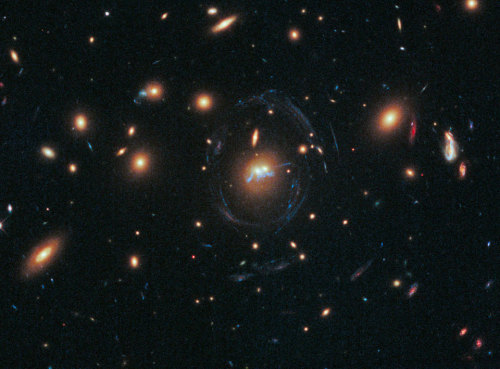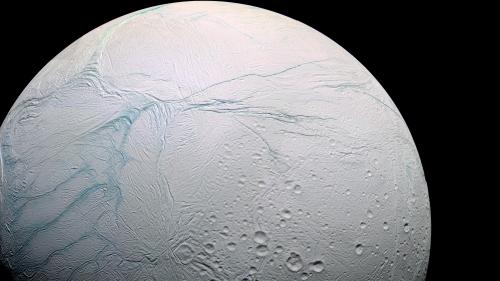Dust, Stars, And Cosmic Rays Swirling Around Comet 67P/Churyumov–Gerasimenko, Captured By The Rosetta
Dust, stars, and cosmic rays swirling around Comet 67P/Churyumov–Gerasimenko, captured by the Rosetta probe. (Source)
More Posts from Intergalacticnerd and Others

A Blue Bridge of Stars between Cluster Galaxies designated SDSS J1531+3414
Views of Pluto
10 Images to Celebrate the Historic Exploration of the Pluto System
One year ago, our New Horizons mission made history by exploring Pluto and its moons – giving humankind our first close-up look at this fascinating world on the frontier of our solar system.

Since those amazing days in July 2015, the New Horizons spacecraft has transmitted numerous images and many other kinds of data home for scientists and the public alike to study, analyze, and just plain love. From Pluto’s iconic “heart” and sweeping ice-mountain vistas to its flowing glaciers and dramatic blue skies, it’s hard to pick just one favorite picture. So the mission team has picked 10 – and in no special order, placed them here.
Click the titles for more information about each image. You’ve seen nine of them before, and the team added a 10th favorite, also sure to become one of New Horizons’ “greatest hits.”
Vast Glacial Flows

In the northern region of Pluto’s Sputnik Planum, swirl-shaped patterns of light and dark suggest that a surface layer of exotic ices has flowed around obstacles and into depressions, much like glaciers on Earth.
Jagged Ice Shorelines and Snowy Pits

This dramatic image from our New Horizons spacecraft shows the dark, rugged highlands known as Krun Macula (lower right), which border a section of Pluto’s icy plains.
Blue Skies

Pluto’s haze layer shows its blue color in this picture taken by the New Horizons Ralph/Multispectral Visible Imaging Camera (MVIC). The high-altitude haze is thought to be similar in nature to that seen at Saturn’s moon Titan.
Charon Becomes a Real World

At half the diameter of Pluto, Charon is the largest satellite relative to its planet in the solar system. Many New Horizons scientists expected Charon to be a monotonous, crater-battered world; instead, they’re finding a landscape covered with mountains, canyons, landslides, surface-color variations and more.
The Vistas of Pluto

Our New Horizons spacecraft looked back toward the sun and captured this near-sunset view of the rugged, icy mountains and flat ice plains extending to Pluto’s horizon. The backlighting highlights over a dozen layers of haze in Pluto’s tenuous but distended atmosphere.
The Dynamic Duo: Pluto and Charon in Enhanced Color

The color and brightness of both Pluto and Charon have been processed identically to allow direct comparison of their surface properties, and to highlight the similarity between Charon’s polar red terrain and Pluto’s equatorial red terrain. Pluto and Charon are shown with approximately correct relative sizes, but their true separation is not to scale.
Strange Snakeskin Terrain

A moment’s study reveals surface features that appear to be texturally ‘snakeskin’-like, owing to their north-south oriented scaly raised relief. A digital elevation model created by the New Horizons’ geology shows that these bladed structures have typical relief of about 550 yards (500 meters). Their relative spacing of about 3-5 kilometers makes them some of the steepest features seen on Pluto.
Pluto’s Heart

This view is dominated by the large, bright feature informally named the “heart,” which measures approximately 1,000 miles (1,600 kilometers) across. The heart borders darker equatorial terrains, and the mottled terrain to its east (right) are complex. However, even at this resolution, much of the heart’s interior appears remarkably featureless—possibly a sign of ongoing geologic processes.
Far Away Snow-Capped Mountains

One of Pluto’s most identifiable features, Cthulhu (pronounced kuh-THU-lu) stretches nearly halfway around Pluto’s equator, starting from the west of the great nitrogen ice plains known as Sputnik Planum. Measuring approximately 1,850 miles (3,000 kilometers) long and 450 miles (750 kilometers) wide, Cthulhu is a bit larger than the state of Alaska.
Colorful Composition Maps of Pluto

The powerful instruments on New Horizons not only gave scientists insight on what Pluto looked like, their data also confirmed (or, in many cases, dispelled) their ideas of what Pluto was made of. These compositional maps – assembled using data from the Linear Etalon Imaging Spectral Array (LEISA) component of the Ralph instrument – indicate the regions rich in ices of methane (CH4), nitrogen (N2) and carbon monoxide (CO), and, of course, water ice (H2O).
Make sure to follow us on Tumblr for your regular dose of space: http://nasa.tumblr.com

This week, NASA released the most colorful, in-depth photo of the universe ever taken. It took the Hubble Telescope 11 years and 840 orbits to capture the 12-billion-year-old light of 10,000 galaxies.
via Mashable

Grasping the stars 💫⭐

Psychedelic Pluto : New Horizons scientists made this false color image of Pluto using a technique called principal component analysis to highlight the many subtle color differences between Plutos distinct regions.
js
how to get an alien to abduct you



Views of the Space Shuttle Atlantis undocking from the Mir space station on July 4, 1995. Cosmonauts Anotoliy Slovyev and Nikolai Budarin unparked the Soyuz spacecraft from Mir to perform a short fly-around when they snapped these astonishing photos. (NASA)

A stunning high res photo of Saturn’s Moon Enceladus

NGC 660. A rare galaxy type, polar ring galaxies have a substantial population of stars, gas, and dust orbiting in rings nearly perpendicular to the plane of a flat galactic disk. Only about a dozen of such galaxies have been discovered
Source: https://imgur.com/z73B8o3

Do not go where the path may lead, go instead where there is no path and leave a trail. —Ralph Waldo Emerson
-
 coolcalmcollector-blog liked this · 3 weeks ago
coolcalmcollector-blog liked this · 3 weeks ago -
 imnotalwaysdreamingoftrains reblogged this · 1 month ago
imnotalwaysdreamingoftrains reblogged this · 1 month ago -
 bambi666 liked this · 1 month ago
bambi666 liked this · 1 month ago -
 sailingonstarstufff liked this · 2 months ago
sailingonstarstufff liked this · 2 months ago -
 27koi liked this · 3 months ago
27koi liked this · 3 months ago -
 jirving liked this · 3 months ago
jirving liked this · 3 months ago -
 columbidaae liked this · 3 months ago
columbidaae liked this · 3 months ago -
 pomodoriyum reblogged this · 3 months ago
pomodoriyum reblogged this · 3 months ago -
 diistantpiixels reblogged this · 3 months ago
diistantpiixels reblogged this · 3 months ago -
 montibon99 liked this · 4 months ago
montibon99 liked this · 4 months ago -
 namelessman2 liked this · 5 months ago
namelessman2 liked this · 5 months ago -
 annaw6izj liked this · 6 months ago
annaw6izj liked this · 6 months ago -
 prjulioca liked this · 6 months ago
prjulioca liked this · 6 months ago -
 chatgggg reblogged this · 9 months ago
chatgggg reblogged this · 9 months ago -
 ihaveneverhadaclue reblogged this · 11 months ago
ihaveneverhadaclue reblogged this · 11 months ago -
 april-potter liked this · 11 months ago
april-potter liked this · 11 months ago -
 myu2k2 liked this · 11 months ago
myu2k2 liked this · 11 months ago -
 thisbluelew reblogged this · 11 months ago
thisbluelew reblogged this · 11 months ago -
 thisbluelew liked this · 11 months ago
thisbluelew liked this · 11 months ago -
 i-drew-a-dog liked this · 11 months ago
i-drew-a-dog liked this · 11 months ago -
 itsmiguel2099 liked this · 11 months ago
itsmiguel2099 liked this · 11 months ago -
 invasionzames reblogged this · 11 months ago
invasionzames reblogged this · 11 months ago -
 invasionzames liked this · 11 months ago
invasionzames liked this · 11 months ago -
 gist-maybe reblogged this · 11 months ago
gist-maybe reblogged this · 11 months ago -
 gist-maybe liked this · 11 months ago
gist-maybe liked this · 11 months ago -
 riverrunscold liked this · 11 months ago
riverrunscold liked this · 11 months ago -
 goobleflop liked this · 11 months ago
goobleflop liked this · 11 months ago -
 i-likestuff86 reblogged this · 11 months ago
i-likestuff86 reblogged this · 11 months ago -
 i-likestuff86 liked this · 11 months ago
i-likestuff86 liked this · 11 months ago -
 sopickamechoosemeloveme reblogged this · 11 months ago
sopickamechoosemeloveme reblogged this · 11 months ago -
 sopickamechoosemeloveme liked this · 11 months ago
sopickamechoosemeloveme liked this · 11 months ago -
 dailiojikalyte liked this · 1 year ago
dailiojikalyte liked this · 1 year ago -
 zebravalis liked this · 1 year ago
zebravalis liked this · 1 year ago -
 instantaneousjourney liked this · 1 year ago
instantaneousjourney liked this · 1 year ago -
 headlesssamurai liked this · 1 year ago
headlesssamurai liked this · 1 year ago -
 megaraye reblogged this · 1 year ago
megaraye reblogged this · 1 year ago -
 theroaringofstars liked this · 1 year ago
theroaringofstars liked this · 1 year ago -
 hilltherapy reblogged this · 1 year ago
hilltherapy reblogged this · 1 year ago -
 aliceabsinthe reblogged this · 1 year ago
aliceabsinthe reblogged this · 1 year ago -
 aliceabsinthe liked this · 1 year ago
aliceabsinthe liked this · 1 year ago -
 saphicspacesociety17 reblogged this · 1 year ago
saphicspacesociety17 reblogged this · 1 year ago -
 juan-en-los-alpes liked this · 1 year ago
juan-en-los-alpes liked this · 1 year ago -
 onlythoughtdaughter reblogged this · 1 year ago
onlythoughtdaughter reblogged this · 1 year ago -
 ghostmartin reblogged this · 1 year ago
ghostmartin reblogged this · 1 year ago -
 ant777stuff liked this · 1 year ago
ant777stuff liked this · 1 year ago -
 legohlas liked this · 1 year ago
legohlas liked this · 1 year ago
"Astronomy compels the soul to look upwards and leads us from this world to another." - Plato
147 posts